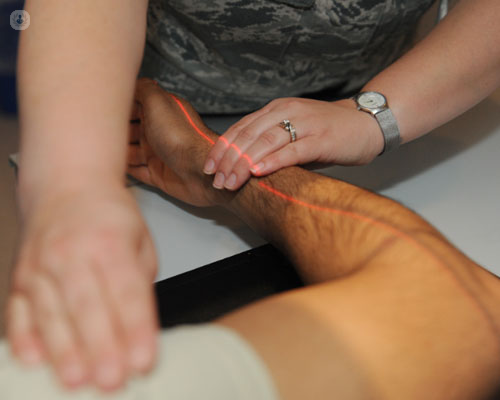

What is a fractured elbow?
An elbow fracture is when there is a break in one or more of the three bones that make up the elbow joint. It normally happens after an injury, like a blow to the elbow, a fall, or a twist. The fracture may also be sprained, strained, or dislocated. Fractures can be:
- Bone fissure: it is a clean break, but there could be complications.
- Displaced: where two ends of the bone separate.
- Non-displaced: the bone is broken but stays in place.
- Open: when the bone goes through the skin.
- Comminuted: when the bone breaks in many pieces.
The most common types of fracture are:
- Radial head and neck fracture: the patient is in more pain when rotating the palm of the hand upwards or downwards. Treatment will depend on what kind of break it is and how many fragments there are. If it is a complex fracture, the joint may need surgery to be repaired, or to remove or replace the radius (if there are multiple fragments).
- Olecranon fracture: these are usually displaced and require surgery to realign the bones with nails, wires, plates, or screws.
- Distal humerus fracture: these are more common in children and the elderly. They are often associated with nerve or artery damage and should be examined. Treatment is normally surgical and plates or screws are used.
Prognosis
Elbow, ulna, and radius fractures are quite common, especially in backward or hand supported falls, or when there is elbow hyperextension. Although it is not a very serious injury, rehabilitation can take time to recover mobility, especially joint movement.

What are the symptoms?
The most common symptoms are:
- Joint pain and sensitivity.
- Swelling and bruising.
- Elbow, arm, and hand numbness as well as weakness.
- Inability or difficulty to move the arm.
- Arm Deformity or swelling.
A snap may be heard at when the fracture happens. If there is a visible change, it may mean that the bones are out of place or the joint is dislocated.
Medical tests
An orthopaedic surgeon will evaluate the injury. They will first check for skin injuries, then see if the patient has less sensitivity. They will also check if there are any mobility issues. The following tests may be carried out:
- X-rays: to check the bone fracture. If a fracture can’t be seen, it may be a displaced fat pad. More X-rays should be taken from different angles.
- CT scan or MRI scan: this is used to see the fractured bone and to check if surrounding tissues are affected. The contrast dye enables the bones to be seen clearer.
What causes it?
The most common causes for an elbow, radius, and ulna fracture are a fall, a direct blow to the joint, or a twist. Osteoporosis also increases the risk of an elbow fracture.
How can it be prevented?
Elbow fractures are difficult to prevent. However, it is easy to improve symptoms and pain by following the recommendations given by the specialist. Examples of these tend to include:
- Raise the elbow above the heart to reduce inflammation and pain. Propping the elbow up with pillows, moving the fingers, and opening and closing them can help prevent hand stiffness.
- Apply ice to the elbow to help relieve swelling and pain, as well as potential tissue damage. Remember to apply ice through a towel. It should be applied for 15-20 minutes every hour more or less.
- Take painkillers, according to the specialist’s instructions. The patient shouldn’t wait until the pain is unbearable. The specialist will recommend how often they should be taken, and prescribe them.
- Physiotherapy and rehabilitation exercises. The physiotherapist will recommend exercises to improve joint movement as well as to regain muscle strength.
What is the treatment?
Elbow fractures don’t tend to need surgery and are treated with a sling, a cast, or a splint (when there is little risk of the bones moving out of place). Treatment will depend on the patient's age and their daily activities. It is quite common to put a plaster cast on children, as it is unlikely that they’ll have elbow stiffness which is more common in adults. To avoid this, rehabilitation exercises are recommended, along with applying heat, ice, or having massages.
In more serious fractures that are out of place or unstable, surgery may be necessary. The procedure involves replacing and stabilising the bone fragments or removing them. If there is an open fracture and the skin is broken, the wound and bone should quickly be cleaned to avoid the risk of infection.
What specialist should I see?
The specialist who treats elbow fractures is an orthopaedic surgeon, of which there are those who specialise in treating elbows.
